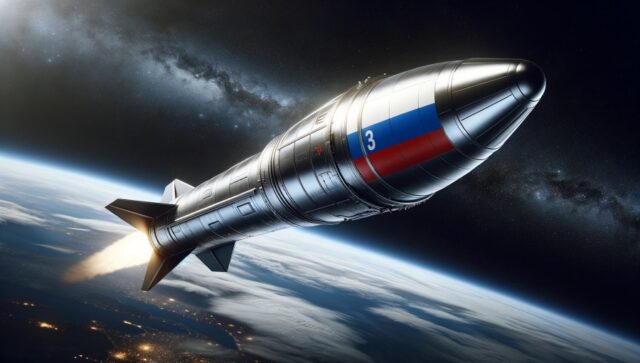
Rumors Spread of Russia’s Prospective Use of Nuclear Weapons in Outer Space
Publication: Eurasia Daily Monitor Volume: 21 Issue: 25
By:

Executive Summary:
- Russia has acknowledged its inability to compete with the West in space and is looking for solutions to shore up the weaknesses of its space program.
- Moscow views the military satellite systems of the United States and its allies as a significant military threat, with concerns growing that these systems could be used to gain military advantages.
- The Kremlin will likely employ the “escalation for de-escalation/nuclear de-escalation” concept to demoralize adversaries during conventional wars and force negotiations, specifically relying on its Strategic Rocket Forces.
On February 14, news spread in Washington that the White House Intelligence Committee was warning of a national security threat from a “destabilizing foreign military capability.” Sources familiar with “deliberations on Capitol Hill” told ABC News that this threat is related to Russia wanting to put a nuclear weapon into space. As these rumors proliferated, the question of how Russia sees the prospects of military activity in space remains unanswered (ABC News, February 14; ABC News, February 15). Moscow realizes it cannot compete with the West in space and relies on an asymmetric approach. As a result, Russian leadership may consider the use of a nuclear warhead in orbit or some nuclear-powered satellite aimed at jamming a relatively large number of commercial satellites as an acceptable measure to counter Western actions in space.
Basic Framework for Russian Decision-Making in Space
Three fundamental aspects define Moscow’s view on militarized activity in space. First, Russia lags behind the West in space innovation and suffers significant problems in satellite navigation, communication, and reconnaissance on the battlefield. Suppose the Global Navigation Satellite System’s (GLONASS) weakness is overcome by using the civilian signals of the United States’ GPS and China’s BeiDou. In that case, the gaps in Russian satellite communication and reconnaissance would take time to close as leaning on supplementary signals would make shoring up GLONASS’s weaknesses less urgent (Voennaya Mysl’, September 2022; Voennaya Mysl’, July 2023; Voennaya Mysl’, January 2024).
Second, Russia sees the superiority of the military satellite systems of the United States and its allies as crucial military threats. These include commercial space systems developed by SpaceX, Planet Labs, Maxar Technologies, and others. Moscow is keenly aware of these systems’ combat advantages for the Ukrainian Armed Forces. Moreover, Russia suspects that US and European private space systems may be used as a cover for Washington’s anti-satellite systems. The Kremlin claims such systems pose a potential combat target for Russia (Defence.council.gov.ru, February 16, 2023; RIA Novosti, February 16, 2023; RIA Novosti, February 16, 2023; Voennaya Mysl’, July 2023; RIA Novosti, October 16, 2023).
Third, Russia’s leadership lacks confidence in its industrial base due to the continuing dependence of Russian satellites on imported electronic components, low production rates (15–17 satellites a year), and the general economic inefficiency of the space industry. Even the number of launch vehicles available for the Russian military would become extremely limited over the long term (TASS, May 3, 2022; RIA Novosti, February 16, 2023; Smotrim.ru, December 26, 2023; Roscosmos.ru, February 15).
Moscow realizes that it cannot compete with the West in space and cannot achieve parity in military space capabilities. As a result, Russia inevitably relies on an asymmetric approach to its military affairs in space.
The ‘Escalation for De-escalation/ “Nuclear De-Escalation’ Concept
For years, Russia has developed its “escalation for de-escalation” concept, also known as “nuclear de-escalation.” The main idea is the demonstrative but limited use of nuclear weapons, primarily non-strategic ones, during an escalating conventional war to demoralize adversaries and force them to negotiate. Recent updates show that the Russian military is considering using its Strategic Rocket Forces to achieve potential “de-escalation.” The concept of “nuclear de-escalation” is still being developed, with some in the Russian military looking to expand on the concept (Voennaya Mysl’, March 2023; Voennaya Mysl’, July 2023).
The Russian military recognizes that it is impossible to damage commercial satellite systems consisting of hundreds and thousands of satellites by targeting a single satellite. Scaled counter-satellite electronic warfare, in turn, would be expensive and technically challenging. Nevertheless, Russian efforts to develop a nuclear-powered spacecraft that could jam electronic satellites en masse are ongoing. That Moscow is still planning for this approach means the option is still on the table despite the myriad technical difficulties with Russia’s space program (Iz.ru, August 31, 2016; EDM, June 9, 2021; RG.ru, June 15, 2021; Kremlin.ru, October 26, 2023).
Another efficient way to damage the constellation of communication and observation satellites is to incite a one-time massive detonation of multiple satellites. In this scenario, the number of destroyed satellites must be higher than the Western companies’ ability to restore the technology before the attack disrupts capabilities on the ground (Voennaya Mysl’, July 2023). Russia’s declared threat of triggering a nuclear explosion on a low orbit with the use of a warhead delivered by an intercontinental ballistic missile or by a high-altitude anti-missile interceptor, similar to what was tested in November 2021, may still be attractive to the Kremlin both in political and technical terms (EDM, December 17, 2021). Moscow’s fixation on possibly using nuclear weapons in space reflects growing desperation to find any possible advantage as its military deteriorates on the Ukrainian battlefield.



